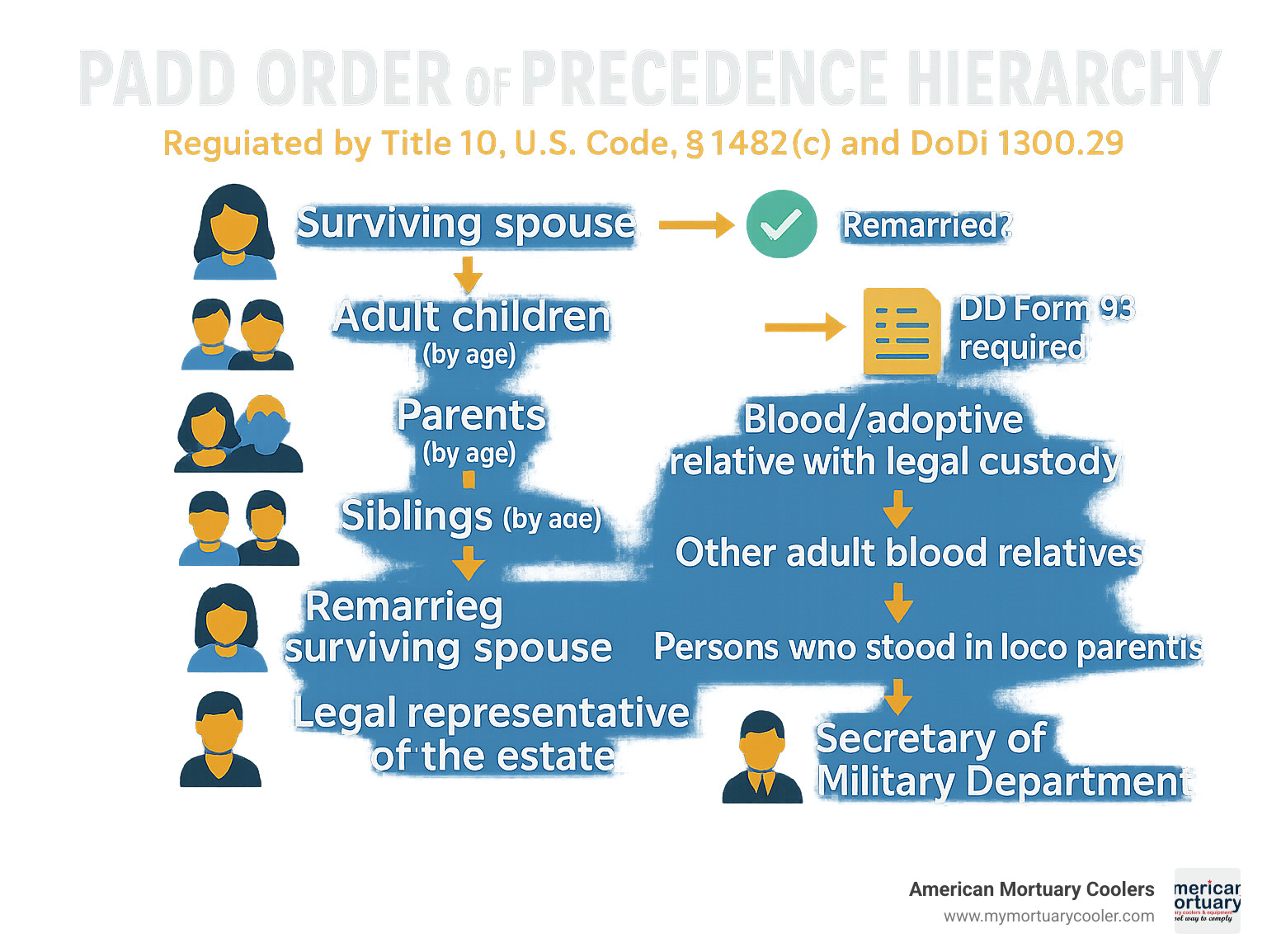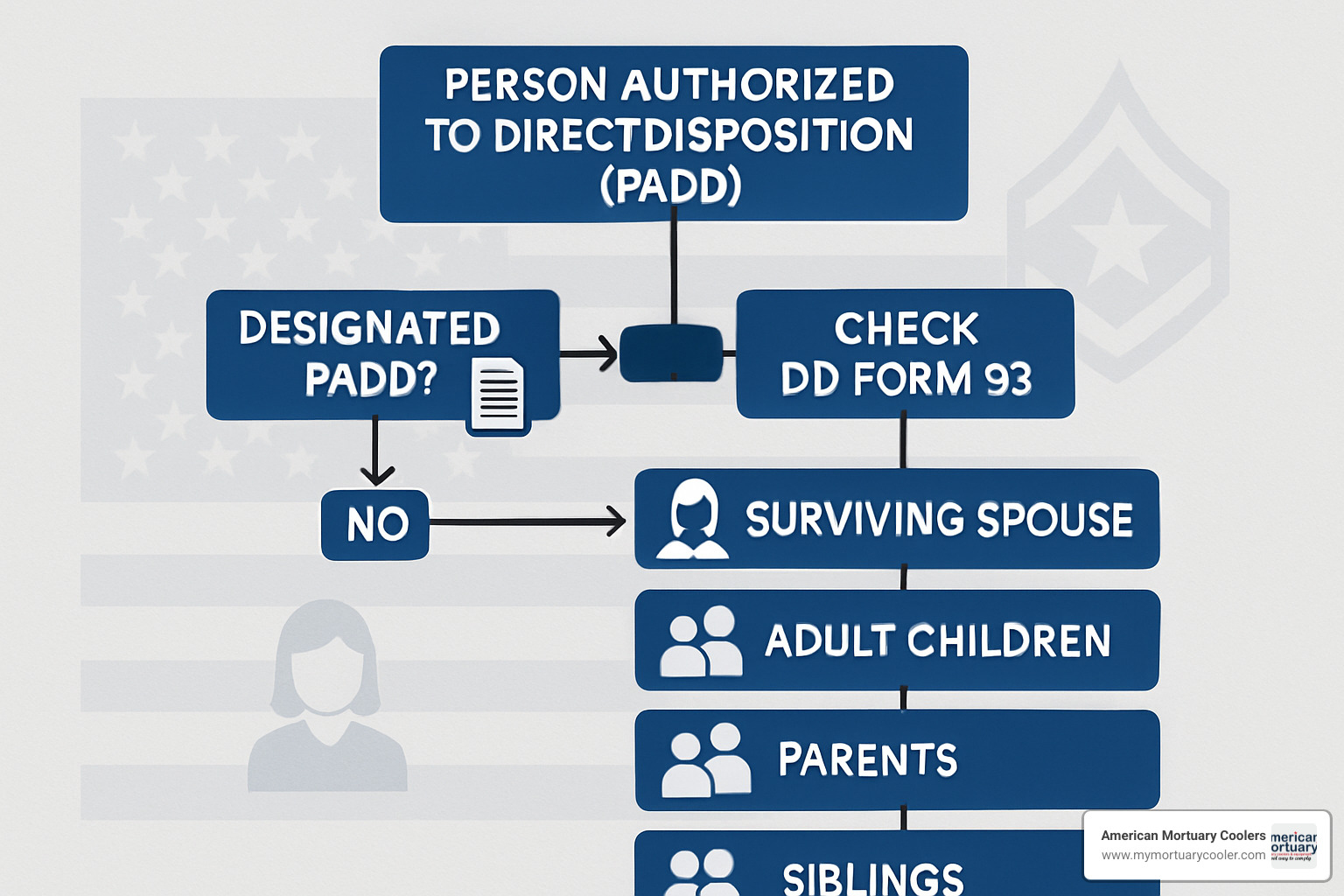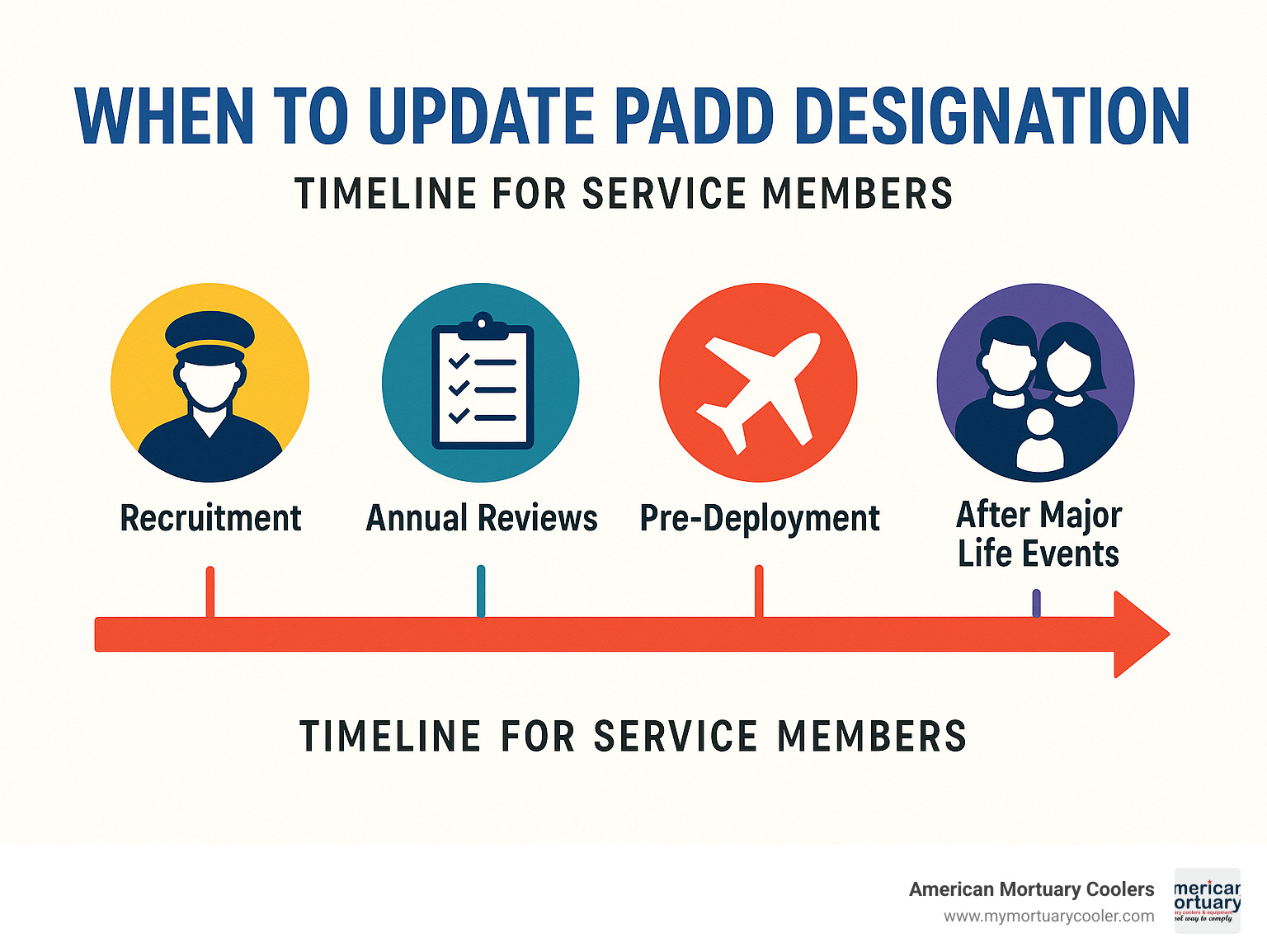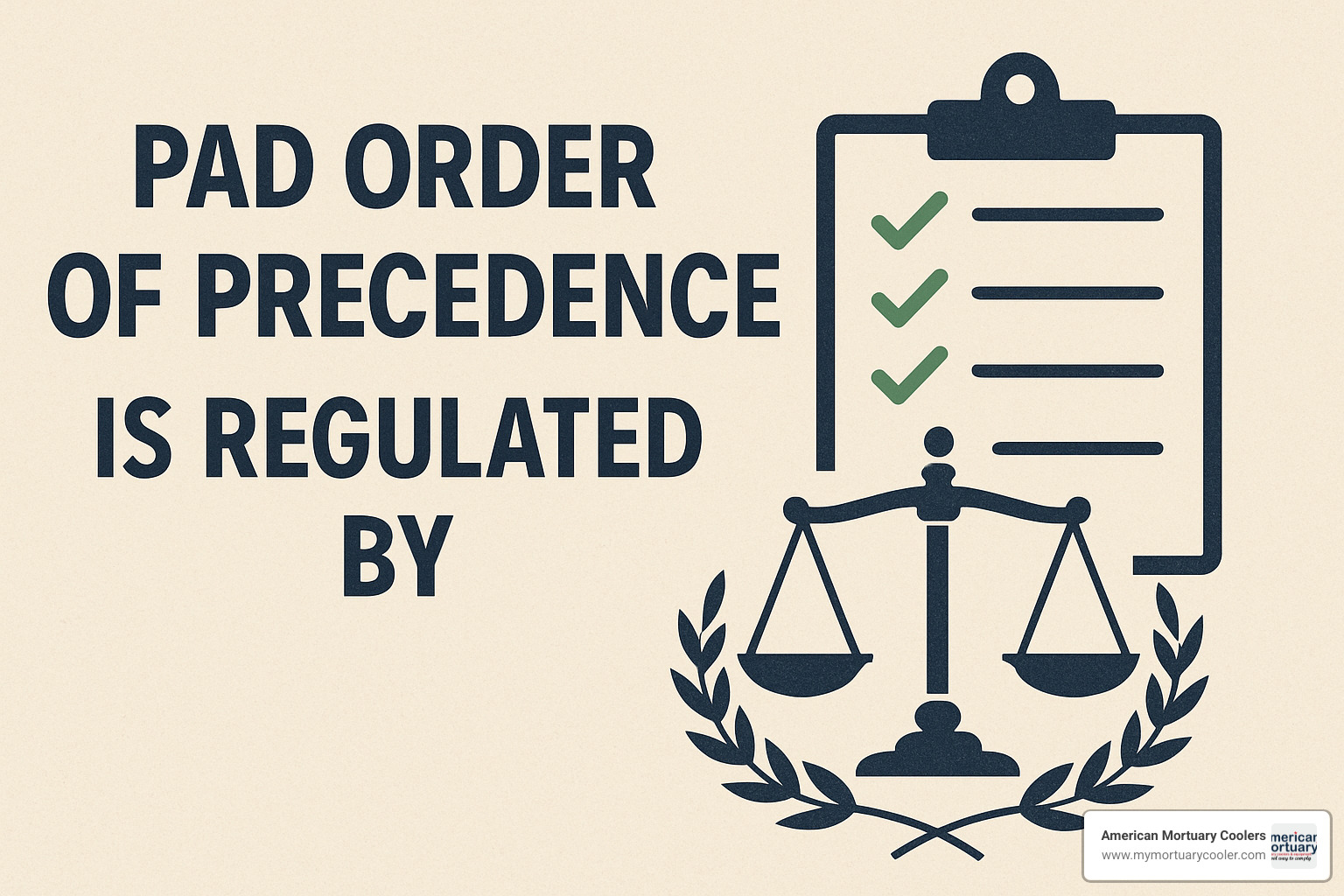Understanding the Legal Framework Behind PADD Designation
The PADD order of precedence is regulated by Title 10, U.S. Code, Section 1482(c) and implemented through Department of Defense Instruction (DoDI) 1300.29. For those seeking a quick answer about this regulatory framework:
| PADD Regulation | Authority |
|---|---|
| Primary Legal Authority | Title 10, U.S.C. §1482(c) |
| Implementation | DoD Instruction 1300.29 |
| Service-Specific Guidance | Branch-specific instructions (MARADMIN, MILPERSMAN, etc.) |
| Form Used | DD Form 93 (Record of Emergency Data) |
When a service member does not designate a Person Authorized to Direct Disposition (PADD), the order of precedence follows this hierarchy:
- Surviving spouse (not remarried)
- Adult children (by age)
- Parents (by age)
- Blood/adoptive relative with legal custody
- Siblings (by age)
- Grandparents (by age)
- Other adult blood relatives
- Remarried surviving spouse
- Persons who stood in loco parentis
- Legal representative of the estate
- Secretary of the Military Department
Understanding this framework is essential for funeral directors who may interact with military families during their most difficult moments. The regulations ensure clear authority for making decisions about a service member's remains, providing structure during emotionally challenging times.
The PADD designation matters because it determines who has the legal authority to make critical decisions about the disposition of a deceased service member's remains. This includes choices about burial location, cremation, funeral arrangements, and other important end-of-life decisions.
I'm Mortuary Cooler, a national-level mortuary cooler supplier with extensive experience helping funeral homes steer the complexities surrounding the PADD order of precedence that is regulated by military protocols and federal law.

What Is a PADD and Why Does Precedence Matter?
When a military family faces the loss of their service member, the last thing they need is confusion about who makes final arrangements. That's where the PADD comes in.
A Person Authorized to Direct Disposition (PADD) is the individual legally empowered to make decisions about a fallen service member's remains. Service members designate their PADD on the DD Form 93, commonly called the Record of Emergency Data or RED. This isn't just another military form – it's perhaps the most important document a service member completes.
Why does the order of precedence matter so deeply? When tragedy strikes, especially during overseas deployments or combat operations, decisions about remains must happen quickly and respectfully. The PADD order of precedence is regulated by clear guidelines to ensure:
- The service member's wishes are honored through their chosen representative
- Military casualty officers know exactly who to contact without delay
- The dignified transfer proceeds smoothly, maintaining the respect our fallen deserve
- Family conflicts don't interfere with timely decisions during an already painful time
At American Mortuary Coolers, we've seen how these regulations provide structure during chaos. Our Tennessee-built mortuary coolers often serve in funeral homes supporting military families, and we understand the importance of dignity in every step of this journey.
The Role vs. PNOK, SNOK & PERE
Military casualty procedures involve several important designations that sometimes confuse families. Let me clarify the differences:
The Primary Next-of-Kin (PNOK) is the person most closely related to the service member according to military regulations. This person becomes the military's main point of contact and receives certain benefits like the death gratuity (unless specified otherwise).
The Secondary Next-of-Kin (SNOK) includes other close relatives who aren't the PNOK. They receive information and support but have fewer legal rights regarding decisions.
The Person Eligible to Receive Effects (PERE) receives the service member's personal belongings. Like the PADD, this person is specifically designated on the DD Form 93.
What makes these roles different from the PADD? The PADD has the specific authority over remains disposition, while the PNOK handles broader notification and benefit matters. Only the PADD can decide about burial location, cremation options, and funeral arrangements.
PADD Order of Precedence is Regulated By: Statutory & DoD Framework
When it comes to honoring our fallen service members, nothing is left to chance. The PADD order of precedence is regulated by a carefully structured legal framework that ensures clarity during life's most difficult moments.
At the foundation of this framework sits Title 10, U.S. Code, Section 1482(c). This federal statute establishes who can make decisions about a deceased service member's remains. Building on this foundation, the Department of Defense created DoDI 1300.29, which puts the law into practical action. This instruction lays out detailed policies and procedures for the entire DoD Mortuary Affairs Program.
Working alongside this, DoDI 1300.18 (Department of Defense Casualty Matters) connects the dots between PADD designation and other important next-of-kin considerations.
Congress occasionally updates these regulations through the National Defense Authorization Act (NDAA). For example, the NDAA for fiscal year 2012 made an important change – it allowed service members to designate any adult (18+) as their PADD, removing previous relationship restrictions.
Each military branch then creates its own specific regulations:
- Navy follows MILPERSMAN 1770-010
- Marines use MARADMIN 421/05 and 151/12
- Army relies on AR 638-2
- Air Force implements AFI 34-511
| Comparison | PADD Authority | PNOK Authority |
|---|---|---|
| Primary Role | Directs disposition of remains | Primary point of contact for casualty matters |
| Can Override Service Member's Designation | No | No |
| Legal Basis | 10 U.S.C. §1482(c) | DoDI 1300.18 |
| Typical Decisions | Burial location, cremation, funeral arrangements | Notification of other family, certain benefit claims |
At American Mortuary Coolers, we've seen how important this clear structure is for funeral homes serving military families.
Air Force Mortuary Affairs Operations > About Us > Mortuary Roles
How the PADD Order of Precedence is Regulated By Title 10 & DoD Directives
Title 10, U.S.C. §1482(c) sets everything in motion. This federal law doesn't just suggest who should make decisions – it establishes a specific, legally binding order of precedence.
DoD Instruction 1300.29 then transforms this legal authority into practical, day-to-day procedures. It defines all the key terms so everyone's speaking the same language. It spells out the exact order to follow when determining who has decision-making authority.
When a service member passes away, this system kicks into action immediately. Casualty assistance officers and mortuary affairs specialists first check the DD Form 93 (Record of Emergency Data) to see if the service member designated a PADD. If not, they methodically work through the established order of precedence.
Disputes When PADD Order of Precedence is Regulated By Federal vs. State Law
Since the PADD order of precedence is regulated by federal law through Title 10, this generally trumps conflicting state laws thanks to the Supremacy Clause of the U.S. Constitution.
Many states have their own burial statutes with different priorities for who can make decisions about remains. This creates a legal landscape that can be tricky to steer.
When conflicts arise, there are several paths to resolution. Federal preemption typically applies in active duty military deaths, meaning the Title 10 order of precedence overrides conflicting state laws. Military Judge Advocates often step in to provide guidance on how federal regulations apply to specific situations.
The Official Order of Precedence When No PADD Is Designated
What happens when a service member passes away without naming someone to handle their final arrangements? Thankfully, the military has a clear system in place. The PADD order of precedence is regulated by Title 10 U.S.C. §1482(c) and DoD Instruction 1300.29, creating a straightforward hierarchy that removes guesswork during an already difficult time.
When there's no designated PADD on the DD Form 93, here's who gets the authority, in order:
First comes the surviving spouse who hasn't remarried. If there's no spouse or they've remarried, the responsibility falls to adult children (18 or older), with the oldest child taking precedence.
If there are no adult children, the service member's parents are next in line, again with the older parent having priority. After parents, a blood or adoptive relative who had legal custody through a court decree would be responsible.
Next come siblings (whether full, half, or adopted), followed by grandparents, both following the same age-based priority system. If none of these close relatives are available, other adult blood relatives are considered based on their relationship proximity according to civil law.
A remarried surviving spouse comes next, followed by persons who stood in loco parentis (essentially acted as parents) for at least a year before the service member entered military service.
If all else fails, the legal representative of the estate would make these decisions. As a last resort, the Secretary of the Military Department concerned would step in when no one else on this list is available.

At American Mortuary Coolers, we've seen how important this clear structure is for funeral homes serving military families across our service areas—from Johnson City, Tennessee to Atlanta, Chicago, and beyond.
Exceptions & Special Scenarios
Real life is rarely straightforward, and the military recognizes this with provisions for special circumstances.
A remarried surviving spouse faces a significant change in standing. If they remarried before their service member spouse died, they drop from first place to eighth in the hierarchy. However, if they remarry after their spouse's death, they maintain whatever position they already held in the PADD order.
What about minors as next of kin? The regulations specifically require "adult children" because those under 18 cannot legally serve as the PADD. When the next person in line is a minor, casualty assistance officers continue down the list until reaching a qualified adult.
For service members with dual citizenship, American military regulations take priority regarding remains disposition. That said, if burial will take place in another country, local interment laws must also be respected.
MIA later recovery cases present unique challenges. When a service member previously declared Missing in Action has their remains recovered years later, special rules apply.
Perhaps the most complex situations involve group remains. When multiple service members perish together and their remains cannot be individually identified, each PADD has input on disposition decisions.
Eligibility, Updates & Resolving Ambiguities
Over the years, the rules about who can be named as a PADD have become much more flexible. The National Defense Authorization Act of 2012 (NDAA FY12) brought significant changes that give service members more freedom in choosing who will make decisions about their remains.
Eligible Persons Today's regulations give service members remarkable flexibility—they can choose virtually any adult to be their PADD. This is a welcome change from earlier rules that limited choices to family members only. Now, a service member can designate a trusted friend, a significant other, or even a mentor who truly understands their wishes.
Age 18 Rule The military strictly enforces the requirement that a PADD must be at least 18 years old. This applies both to people specifically chosen as PADD and to those who might become PADD through the default order of precedence. When a minor would normally be next in line, military officials will simply move to the next eligible adult on the list.
Custody vs. Guardianship There's an important distinction in the regulations between legal custody and guardianship. In the official order of precedence, a "blood or adoptive relative granted legal custody by court decree" holds the fourth position. Although guardianship might seem similar, it's not the same as custody when determining PADD status.
DD Form 93 Updates Service members should keep their PADD designation current by completing a new DD Form 93 whenever circumstances change. The best times to update this form include:
- During your annual record reviews
- Before heading out on deployment
- After major life events like marriage, divorce, or having children
- When important relationships in your life change

Failure to Respond & Re-designation Sometimes a designated PADD can't be located or doesn't provide instructions within a reasonable timeframe—typically 48 hours. When this happens, PADD order of precedence is regulated by DoD procedures that allow for re-designation following the established hierarchy.
Dispute Resolution When questions or disagreements arise about who has PADD authority, the military has established clear procedures to resolve these issues. These might include a review by the Service Secretary's representative, consultation with military legal officers (Judge Advocates), or formal dispute resolution boards for complex situations.

Practical Steps to Change or Confirm Your PADD
If you're a service member wanting to make sure your wishes are honored, taking a few simple steps to update your PADD designation can provide peace of mind for you and clarity for your loved ones.
Visit Your Personnel Office Your unit's administrative office, personnel support detachment, or equivalent office is the place to start. The staff there can help you update your Record of Emergency Data (RED)/DD Form 93 correctly.
Complete the Form Properly The DD Form 93 requires a witness signature, which helps prevent any questions about whether you really made the designation. This simple step adds an important layer of protection for your wishes.
Be Crystal Clear When naming your PADD, include all the details: their full legal name, their relationship to you (even though it's not required, it helps provide context), current address, phone number, and email if available.
Keep Your Own Copy After updating your DD Form 93, ask for a personal copy. This simple step can be invaluable for your designated PADD if questions ever arise about your intentions.
Talk to Your Designated PADD While not required by regulations, having a conversation with the person you've chosen as your PADD is just good common sense. Make sure they're willing to accept this responsibility and share any specific wishes you have about your remains.
More info about funeral director equipment
Family Dynamics & State Interaction
When it comes to handling a service member's final arrangements, family relationships and state laws create a mix of considerations that can be challenging to steer.
Divorce changes everything in PADD designations. When a service member divorces, their ex-spouse automatically loses PADD status unless the service member specifically redesignates them after the divorce is finalized. This is why we always remind military personnel to review their DD Form 93 after major life changes.
Remarriage brings its own considerations. A new spouse doesn't automatically become the PADD without an updated form. Interestingly, if a surviving spouse remarries after the service member's death, they generally maintain their PADD status for any remaining decisions.
Adoption creates bonds that are fully recognized in the PADD framework. Adopted children stand equal with biological children, and adoptive parents have identical standing to birth parents.
The regulations specifically mention legal custody in the fourth position of the precedence order. This recognizes court-ordered arrangements but requires proper documentation.
Domestic partnerships have seen evolving recognition over time. Following the Obergefell v. Hodges Supreme Court decision, DoD policy recognizes same-sex spouses for PADD determination. However, non-marital domestic partnerships may not receive the same recognition.
While the PADD order of precedence is regulated by federal law, the practical reality is that burials must comply with state requirements. The designated PADD must work within state frameworks that include obtaining state burial permits, following local cemetery regulations, and adhering to state cremation authorization processes.
Organ donation decisions sometimes fall under different regulations than PADD determination. State anatomical gift laws may apply alongside federal PADD regulations, creating situations where different authorities might make different decisions.

At American Mortuary Coolers, we understand these complex family and legal interactions. Our custom mortuary coolers, proudly made in Tennessee, are designed to provide the sometimes extended preservation time needed while complex PADD determinations are resolved.
More info about mortuary coolers
Frequently Asked Questions about PADD Order of Precedence Regulation
Who can override a designated PADD?
When families come to us with questions about who has the final say in military funeral arrangements, this is often at the top of their list. The simple answer? No one can directly override a properly designated PADD.
The service member's choice on their DD Form 93 is sacred in the eyes of military regulations. It's their final decision about who they trust to handle their remains with dignity and respect.
That said, there are a few limited situations where a designated PADD's authority might shift:
If the military can't find the designated person after making genuine efforts to reach them, they'll move down the list to the next eligible person. Similarly, if the PADD is located but doesn't provide instructions within about 48 hours, the military may need to continue the process with someone else.
In cases where the designated PADD has become legally incompetent, their court-appointed guardian would step in. And in extraordinarily rare circumstances, the Secretary of the Military Department might have to intervene if the PADD's decisions would clearly violate law or the documented wishes of the deceased.
What happens if the PADD cannot be located in 48 hours?
When a designated PADD seems to have vanished, the military follows a careful protocol:
First, they'll make thorough attempts to reach the person through all available channels - phone calls, emails, physical address visits, and sometimes even social media. Every attempt is documented with dates, times, methods used, and results.
After exhausting reasonable efforts for about 48 hours, the military prepares written documentation stating that the designated PADD couldn't be located. This isn't done lightly - it's a formal acknowledgment that despite their best efforts, they need to move forward.
The process then shifts to the next eligible person in the order of precedence regulated by Title 10. This continues until someone is found who can and will provide the needed disposition instructions.
Does a will affect the PADD hierarchy?
This question creates more confusion for families than almost any other aspect of military mortuary affairs. The straightforward answer is no - a will generally does not affect the PADD hierarchy established by military regulations.
The PADD order of precedence is regulated by federal law (specifically Title 10 U.S.C. §1482(c)) and DoD instructions, creating a system that operates independently from state probate laws. This means that even if a service member expresses wishes about their funeral or remains in their will, those instructions don't legally override the designated PADD's authority.
Why this separation? Military death benefits operate under federal jurisdiction, while wills primarily function under state law. The DD Form 93 was specifically created to address military-specific matters like PADD designation without getting tangled in potentially lengthy probate proceedings.
Conclusion
Understanding how the PADD order of precedence is regulated by federal law might seem complicated, but it's actually designed to bring clarity during life's most difficult moments. For funeral directors serving military families, this knowledge isn't just about compliance—it's about providing compassionate care when families need it most.
The framework established by Title 10 and DoD instructions creates a roadmap that helps everyone steer the emotional journey of laying a service member to rest. When you know exactly who has the legal authority to make decisions, you can focus on what really matters: honoring the fallen with dignity and respect.
Throughout this guide, we've explored several important aspects of PADD regulations that funeral professionals should keep close to heart:
The DD Form 93 stands as the cornerstone document where service members make their wishes known. This simple form carries tremendous weight when difficult decisions must be made.
When no PADD is designated, the clear hierarchy established in the regulations provides a straightforward path forward, helping to minimize family disputes during an already painful time.
We've also clarified the sometimes confusing alphabet soup of military designations—PADD, PNOK, SNOK, and PERE—each with distinct roles and responsibilities in the aftermath of a service member's death.
Here at American Mortuary Coolers, we've worked alongside funeral homes serving military families from coast to coast. Our Tennessee-built mortuary coolers are designed with these unique situations in mind, where timing and dignified care go hand in hand. We understand that sometimes PADD determinations take time, and proper preservation equipment ensures the service member is cared for respectfully throughout the process.
We're proud to support funeral homes across America—from Johnson City to Los Angeles, Chicago to Dallas, and everywhere in between—as they perform this sacred duty for those who served our country.


















